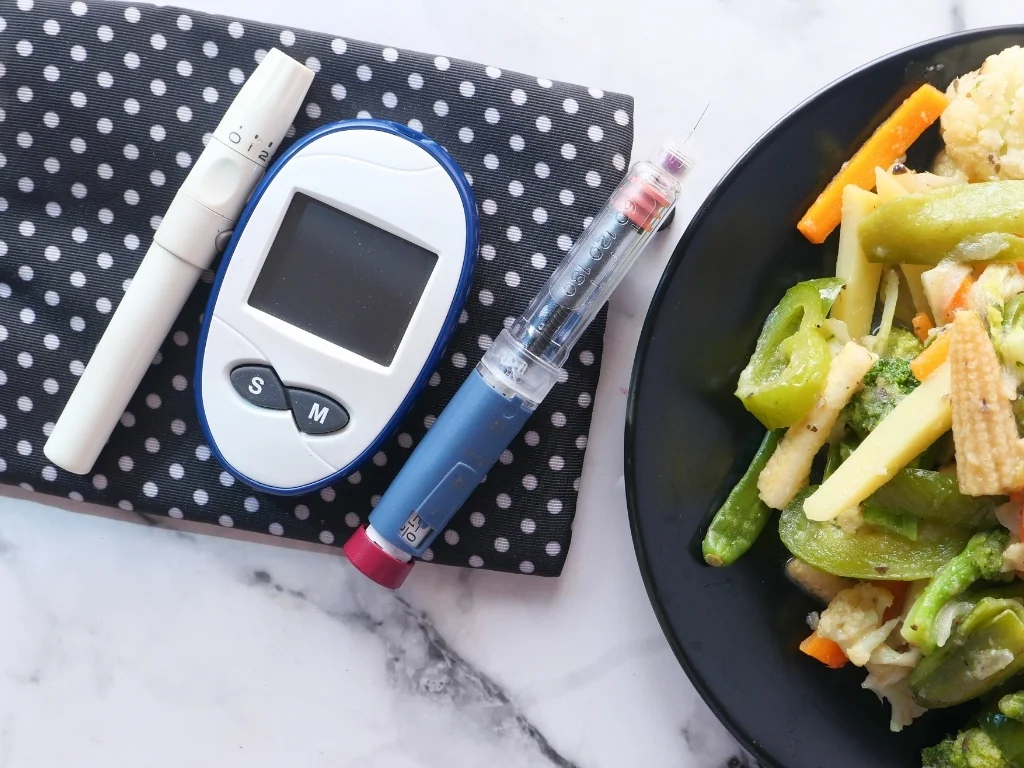When you get diagnosed with gestational diabetes, it’s natural to worry about what this means for you and your baby. But the truth is, you have a lot more power over the situation than you might think.
Gestational diabetes happens when your body can’t use sugar as efficiently as it should during pregnancy, leading to higher levels of blood glucose. As serious as it sounds, this condition is very manageable with the right food choices and eating habits.
Adopting a well-balanced gestational diabetes diet plan is an excellent place to start, and the best part is you don’t have to completely give up flavor or enjoyment to stay nourished. In this guide, we’ll show you how to fill your plate with wholesome foods that help manage diabetic pregnancy by keeping your blood sugar steady, your energy strong, and your little one healthy.

What to eat with gestational diabetes
The key to managing gestational diabetes is not to restrict yourself, but rather to aim for balance in every meal. Using the following food groups as building blocks for your gestational diabetes diet plan ensures that you get the nutrients you and your baby need for a healthy pregnancy.
Lean proteins
Including a source of protein in each meal and snack, whether plant- or animal-based, can help prevent blood sugar from rising too quickly after eating. Protein slows your body’s absorption of carbohydrates, allowing glucose and energy levels to stay more consistent throughout the day. It also contains essential amino acids that support your baby’s growth.
For balanced nutrition, opt for lean sources like chicken, turkey, eggs, tofu, beans, lentils, and low-mercury fish such as salmon or tuna.
Healthy fats
Not all fats play the same role in the body. Including a variety of nutrient-dense fat sources can help support stable blood sugar and round out your list of foods to eat with gestational diabetes.
Avocados, olive oil, nuts, seeds, and oily fish provide omega-3 and omega-6 fatty acids that play a vital role in how your little one’s brain, eyes, and nervous system develop. These fats also enable your body to absorb fat-soluble vitamins, which can reduce inflammation and improve insulin sensitivity.
High-fiber carbs
Contrary to popular belief, carbohydrates aren’t the enemy. It’s all about selecting the right kinds to consume. High-fiber, low-glycemic options like oats, brown rice, quinoa, lentils, and sweet potatoes break down more slowly in your body, releasing glucose also at a slower, steadier pace. This gradual digestion helps prevent sudden spikes in blood sugar and keeps your energy more stable.
Complex carbs also contain essential nutrients like B vitamins and minerals that fuel your body’s energy production and aid in the development of your baby’s brain and nervous system.
Non-starchy vegetables
Experts suggest filling half your plate with colorful, non-starchy vegetables like spinach, peppers, cauliflower, and zucchini. These foods are rich in fiber, vitamins, and antioxidants that slow down the release of sugar into your bloodstream.
Their high nutrient content — especially folate, vitamin C, and iron — also supports your baby’s cell growth, brain development, and immune system.
Low-glycemic fruits
When building a gestational diabetes diet plan, reach for low-glycemic fruits such as strawberries, raspberries, apples, plums, peaches, oranges, and lemons. Their fiber and antioxidants help stabilize blood sugar, while their vitamin C supports your baby’s tissue development.
Calcium-rich foods
Getting enough calcium doesn’t just ensure your own bone health. During pregnancy, your little one draws the calcium they need directly from your body, so it’s crucial to consume foods rich in this nutrient. Calcium helps build your baby’s bones and teeth and also supports the development of their heart, nerves, and muscles.
Dairy products like yogurt, low-fat milk, and cheese are common sources, though there are plenty of plant-based alternatives to choose from, including:
- Fortified plant milks and tofu
- Leafy greens like kale, collard greens, and bok choy
- Nuts like pistachios and almonds
- Legumes and seeds, such as sesame seeds, chia seeds, and white beans

Water and unsweetened beverages
Staying well-hydrated helps your body keep your blood glucose lower and works along with fiber for healthy digestion, which is important since constipation is a common pregnancy complaint.
For your baby, good hydration ensures a steady flow of nutrients and oxygen through the placenta. Water is your best choice, but unsweetened herbal teas or sparkling water with a squeeze of lemon can add variety if you prefer something different. Just remember that not all teas are pregnancy-safe, so it’s best to double-check with your provider.
It can be hard to build your own gestational diabetes diet plan, especially if some of these foods don’t seem to work well for you. On the upside, you don’t have to figure everything out by yourself. Consult a registered dietitian nutritionist (RDN) to make portion control and meal planning more streamlined, personalized, and effective.
What to limit with gestational diabetes
No food has to be completely cut out of your diet when managing gestational diabetes. However, it’s essential to practice moderation and consider swapping items that cause blood sugar spikes for healthier alternatives. Below are some foods to limit with gestational diabetes.
Refined and high-starch carbs
Refined carbs like white bread, white rice, and white pasta are stripped of fiber, making them much easier for the body to absorb and break down into glucose. Potatoes can have a similar effect, though preparation plays a big role — cooled potatoes or potatoes eaten with protein and fat tend to have a gentler impact on blood glucose.
High-sugar foods and drinks
Sugary beverages — including sodas, sweetened teas, and ready-to-drink coffee — are some of the fastest ways to raise blood glucose. Even fruit juices marketed as “natural” can contain concentrated sugars that spike blood sugar in a similar way to soda.
Fried and highly processed foods
Foods that are high in trans fats, sodium, and simple carbs contribute to excess weight gain, which can increase the risk of type 2 diabetes. As tempting and convenient as fast food, sugary breakfast cereals, and instant noodles can be, it’s best to keep them to a minimum.
Foods you personally cannot tolerate
Pregnancy can bring new aversions or sensitivities to foods that aren’t necessarily unhealthy. Certain textures, flavors, or smells might trigger pregnancy nausea, and that can make sticking to a gestational diabetes diet plan feel more challenging. If this happens, don’t be hard on yourself.
A registered dietitian nutritionist can help you identify foods you can comfortably tolerate while still supporting balanced blood sugar. They can also guide you in maintaining a healthy approach to nutrition that works with your symptoms — not against them.

Sample 7-day meal plan for a gestational diabetes-friendly diet
This flexible, week-long diet plan for gestational diabetes lists food you can rely on for balance and variety that keeps you and your child healthy. From breakfast and lunch to dinner ideas for gestational, you’ll find reliable choices to keep your blood sugar steady throughout the day.
Each meal features nutrient-dense foods that are easy to find and prepare, and a registered dietitian can help you fine-tune portions, timing, and ingredients to match your personal needs.
Day 1
- Breakfast: Fiber-rich yogurt bowl with grated carrot and a medium apple
- Lunch: Grilled chicken breast and roasted tomato salad with lettuce, drizzled with light dressing
- Dinner: Baked salmon with brown rice and steamed green beans
- Snack: Apple slices with a tablespoon of nut butter of your choice (peanut or almond recommended)
Day 2
- Breakfast: Two slices of whole-grain bread, preferably toasted, some scrambled eggs with nut butter of your choice, and a side of oranges
- Lunch: Soybean salad with tilapia, carrot, cucumber, and lemon dressing
- Dinner: Thai basil chicken stir-fry with broccoli, onions, and vegetables of choice, served with brown rice
- Snack: Handful of almonds and strawberries
Day 3
- Breakfast: Mushroom medley and spring onion omelet
- Lunch: Mediterranean quinoa salad with roasted vegetables and feta cheese
- Dinner: Tuna wrap in a whole-grain tortilla with salsa, mixed veggies, and shredded cheddar cheese, served with fruit and a glass of low-fat milk
- Snack: Boiled egg and a few cherry tomatoes
Day 4
- Breakfast: Scrambled egg with spinach and tomato on whole-grain toast, plus milk of choice and melon
- Lunch: Roasted zucchini, bell peppers, and carrots with chickpeas and whole-grain pasta
- Dinner: Baked eggplant stuffed with tofu, mushrooms, and beans
- Snack: Carrot or cucumber sticks with hummus
Day 5
- Breakfast: Protein oats with almond milk, topped with half a banana and a spoonful of peanut butter
- Lunch: Greek-style chicken pita, with a side of carrot sticks or fresh tomato salad
- Dinner: Stir-fried noodles (whole-wheat or brown rice) with broccoli, garlic, sesame oil, and red chili flakes, served with fried tofu
- Snack: Greek yogurt with fruit of your choice and a sprinkle of cinnamon
Day 6
- Breakfast: Whole-wheat English muffin breakfast sandwich with turkey bacon, egg, lettuce, and tomato, served with slices of melon
- Lunch: Vegetable soup and chicken avocado salad wrap with red onions and shredded spinach
- Dinner: Baked salmon fillet with brown rice, steamed green beans, and herbs
- Snack: Half a whole-wheat pita with caramelized onion hummus and crisp cucumber slices
Day 7
- Breakfast: Savory steel-cut oats cooked in broth, topped with sautéed vegetables, cheese, and eggs
- Lunch: Chickpea and spinach curry
- Dinner: Spinach, mushrooms, barley pilaf, and a protein of choice, such as chicken, turkey, or tofu
- Snack: Spicy garlic edamame and a piece of fruit

Feel supported and nourished throughout your pregnancy with Health Loft
Managing gestational diabetes can feel overwhelming, but you don’t have to navigate it alone. The right guidance can help you keep your blood sugar steady, stay nourished, and feel confident in the choices you’re making for yourself and your baby.
At Health Loft, we connect you with gestational diabetes nutritionists who provide expert, prenatal-focused dietary guidance. You’ll receive a comprehensive diet plan for managing gestational diabetes based on your blood sugar readings, food preferences, changing nutritional needs, and other factors that shape your well-being at each stage of pregnancy.
You may be wondering, “Does gestational diabetes go away?” In most cases, it does after childbirth. A key part of recovery — and of reducing your long-term risk of type 2 diabetes — is maintaining the mindful eating habits you’ve learned from this guide. Having the right care team makes that easier.
Connect with a dietitian today or learn more about how Health Loft can guide you towards better nutrition.
This article was reviewed by Katie Whitson, RD, LD. It is intended for informational purposes only and does not replace personalized nutritional advice.













